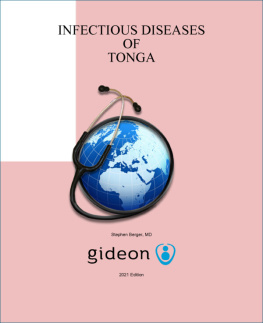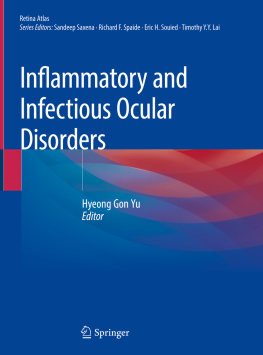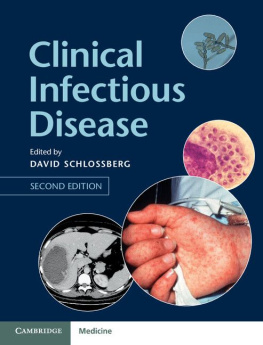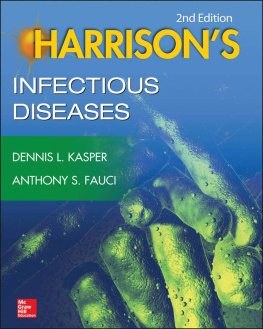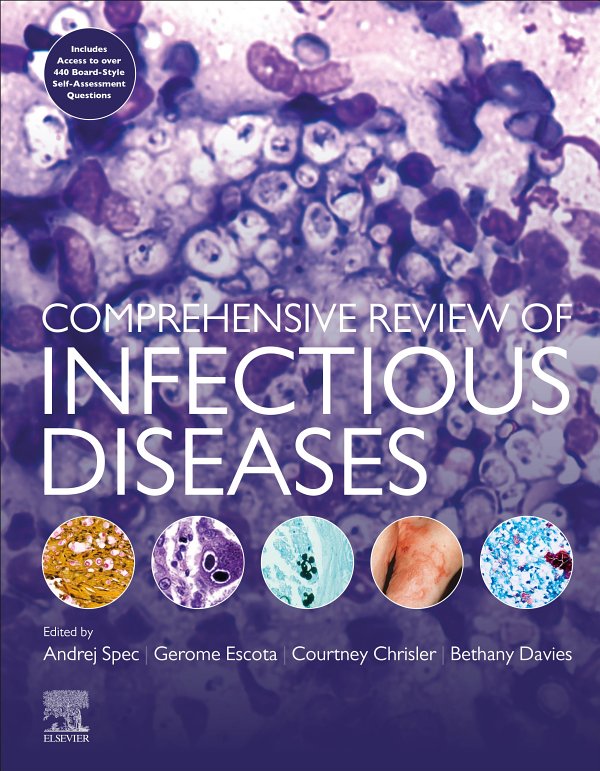Instructions for online access
Thank you for your purchase. Please note that your purchase of this Elsevier eBook also includes access to an online version. Please click here (or go to http://ebooks.elsevier.com) to request an activation code and registration instructions in order to gain access to the web version.
Comprehensive Review of Infectious Diseases
Editors
Andrej Spec, MD, MSCI
Assistant Professor, Division of Infectious Diseases, Washington University in St. Louis School of Medicine, Missouri, United States
Gerome Escota, MD
Assistant Professor of Medicine, Division of Infectious Diseases, Washington University in St. Louis School of Medicine, Missouri, United States
Courtney Chrisler, MD
Assistant Professor, Division of Infectious Diseases, Washington University in St. Louis School of Medicine, Missouri, United States
Bethany Davies, MBBS, MD, FRCPath, MRCP
Senior Lecturer in Infection, Department of Global Health and Infection, Brighton and Sussex Medical School, United Kingdom
Table of Contents
Copyright
2020, Elsevier Limited. All rights reserved.
No part of this publication may be reproduced or transmitted in any form or by any means, electronic or mechanical, including photocopying, recording, or any information storage and retrieval system, without permission in writing from the publisher. Details on how to seek permission, further information about the Publishers permissions policies and our arrangements with organizations such as the Copyright Clearance Center and the Copyright Licensing Agency, can be found at our website: www.elsevier.com/permissions.
This book and the individual contributions contained in it are protected under copyright by the Publisher (other than as may be noted herein).
Notices
Practitioners and researchers must always rely on their own experience and knowledge in evaluating and using any information, methods, compounds or experiments described herein. Because of rapid advances in the medical sciences, in particular, independent verification of diagnoses and drug dosages should be made. To the fullest extent of the law, no responsibility is assumed by Elsevier, authors, editors or contributors for any injury and/or damage to persons or property as a matter of products liability, negligence or otherwise, or from any use or operation of any methods, products, instructions, or ideas contained in the material herein.
Cover images reproduced from:
Michael I. Lewis, Robert J. McKenna, Eds. Medical Management of the Thoracic Surgery Patient. Saunders, 2010. Mucin stain highlights mucinous capsules confirming cryptococcus (red; mucicarmine stain; original magnification 600).
Mack, Megan, Gregg, Kevin. Diagnosis and Management of Infections in Hospitalized Immunocompromised Patients. Hospital Medicine Clinics, Volume 3, Issue 3, e378-e395. Characteristic appearance of CMV intracytoplasmic inclusions, resembling an owls eye.
Ramos-e-Silva, Marcia. Dermatologic Clinics 2008. Volume 26, Issue 2 (April), pp 257-269. Paracoccidioidomycosis.
James W., Berger , Elston D., Neuhaus, I. Andrews Diseases of the Skin 12e. Elsevier, 2016. Cutaneous larva migrans.
Elston D., Ferringer, T., Ko, C.J. et al. Dermatopathology. Elsevier, 2019. Nocardia with Fite stain.
ISBN: 978-0-323-56866-1
Library of Congress Control Number: 2019950904
Content Strategist: Charlotta Kryhl
Content Development Specialist: Kim Benson
Project Manager: Louisa Talbott
Design: Miles Hitchen
Marketing Manager: Michele Milano
Printed in United States of America
Last digit is the print number: 9 8 7 6 5 4 3 2 1

Foreword
There is no doubt that Infectious Diseases is a wonderful specialty for those interested in clinical practice. ID clinicians span the continuum of medicine from research to individual patient care to public health more than any other clinical specialty. The field is continually enriched by innovation in prevention, diagnosis, and therapy. ID clinicians are widely recognized in many settings as the true medical detectives, solving diagnostic dilemmas that challenge other doctors. For the individual patient, it is becoming clearer that, for complex infections, care by an ID physician can save lives. The field is constantly challenged by the emergence of new entities or by the re-emergence of old enemies, emboldened by antimicrobial resistance. For these emerging infections, ID clinicians sound the alarm, educate the public, define treatment, and help halt the spread of disease. The experience with HIV infection, which was transformed from a universally fatal infection to a manageable chronic condition in the space of a generation, demonstrates the power of medical science, but also the pace of change. And as the recent experiences with Ebola and Zika have shown us, these emerging infections are truly global and require a well-educated and prepared clinical workforce.
While these are undoubtedly exciting times for an ID clinician, they are also daunting for a trainee interested in ID and for an established clinician who wishes to catch up on training that occurred years previously. There is a clear need for resources that will aid clinicians in their learning. Certification (and recertification) examinations are one way that modern societies use to demonstrate expertise. It is for this reason I am delighted to support the talented team of editors and contributors who have put this new study guide together. The editors are all young faculty who have recently completed their training and who understand the practicalities of preparing for examinations. They have assembled an impressive international group of authors, to include both current information but also novel study aids and sample questions that will allow for self-testing. This was a daunting challenge and congratulations are due to all involved for such an outstanding outcome. I am sure readers will value their effort and will use the book frequently, both in preparing for examinations or for their own teaching.
Bill Powderly
Preface
Thank you for picking up our labor of love. We created this book following a clear vision: a resident matching into an Infectious Disease fellowship, and on that day realizing the immense amount of knowledge they now need to acquire. Infectious disease (ID) is by far the largest field of medicine, comprising all the organ systems, all the stages of life, and the largest number of different diagnoses. All of this is compounded by the fact that ID physicians are frequently called upon to be the disease detectives in many hospitals and ferret out diseases that are not infectious in nature. It is a scary realization, but at the same time, it is an invitation to a lifetime of learning. We put together this book for that resident, initially to join them as they embark on their fellowship adventure, and then to be referenced during fellowship training so that when the end of fellowship comes, all pages have been read, lovingly dog-eared and underlined or highlighted (or both), and all the questions read and answered a few times over, all in different stages of their evolution as an ID physician. So, as the fellowship ends, all the studying is done, the fellow is now the attending, and the boards hold no fear for them, because they have long been prepared. That was the vision for this book when we first developed it. We made sure that each chapter is written by experts from all aspects of infectious diseases (including Microbiology and Pharmacology), by rising stars in the field who have recently taken the boards and excelled, and by authors who understand the challenges posed by the complexity of this field of study and practice. Our contributors come from all over the world and this gives our book a richer perspective on infectious diseases.


